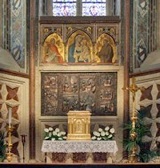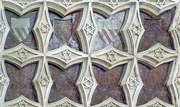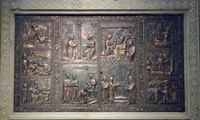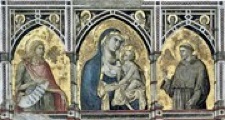This chapel off the back wall of the left transept was first documented in 1404. It also appeared in a list (1509) of burials in San Francesco, which records that Cardinal Napoleone Orsini built it and wished to be buried here. The chapel was designed as a pendant to the Cappella di San Nicolò, which Cardinal Orsini had built before 1297 as a funerary chapel for his brother, Giovanni Gaetano Orsini, and the Orsini arms were displayed:
-
✴on the external walls;
-
✴in the stained glass windows (illustrated above);
-
✴on the frescoes to the sides of the windows (illustrated above); and
-
✴in the decoration of the lower part of the internal walls.
There can, therefore, be little doubt that it was built by Cardinal Orsini, presumably shortly after the completion of the Cappella di San Nicolò.
The decoration of the chapel began with its stained glass and then with the frescoed altarpiece (see below), which is attributed to Pietro Lorenzetti. The picture fields on the wall were also defined by frescoed frames. However, the project then came to a halt, probably because, in 1320, Muzio di Francesco stole the money that Cardinal Orsini had deposited at San Francesco (along with the papal treasure that remained here and property belonging to other depositors). Muzio di Francesco repaid 1,000 gold florins to Cardinal Orsini in 1323, but by then the damage had been done. Cardinal Orsini died in Avignon in 1342 and seems to have been buried in the Cappella di San Marziale, old St Peter’s, Rome.
The chapel was documented as the Cappella del Crocifisso in 1513. Fra Ludovico recorded the presence her of a crucifix that seems to have come from the Cappella di San Sebastiano (see above). This crucifix is now in the Cappella di Santa Caterina.
The niche above the altar that was presumably intended for his tomb was never used. The bronze relief that covers it was installed in 1926, when the Sacro Velo della Madonna was placed here. The reliefs depict scenes from the life of the Virgin.
Madonna and Child with saints (ca. 1315)
The frescoed triptych of the Madonna and Child with SS John the Baptist and Francis, which is above the niche on the altar wall, is attributed to Pietro Lorenzetti. Its design was clearly determined by the altarpiece that is attributed to Giotto and his workshop in the Cappella di San Nicolò.
Stained Glass
The glass that survives in the central bifore, unlike that elsewhere in the lower church, exhibits marked Byzantine influences. It was probably made in Venice and may well have been associated with the granting of a permit (1318) that allowed glass workers from Murano to work at San Francesco.
The stained glass in the two outer bifore windows was replaced in the 18th century because of its poor condition. The surviving scenes in the central bifore represent (from the top):
-
✴an angel announcing to Zacharius the conception of St John the baptist;
-
✴St John the Baptist and Christ; and
-
✴four copies (2x2) of the Orsini arms, the lower two of which are visible in the illustration above.







